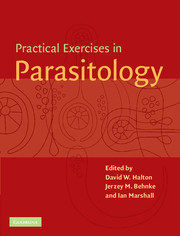Book contents
- Frontmatter
- Contents
- List of contributors
- Preface
- General advice
- 1 Observational Exercises on Parasites
- A Local wild and domestic hosts as sources of parasites
- 1.1 Parasites of the earthworm: Monocystis (Protozoa) and Rhabditis (Nematoda)
- 1.2 Parasites of marine molluscs (Littorina)
- 1.3 Parasites offish: (a) Whiting and Diclidophora merlangi (Monogenea)
- 1.4 Parasites of fish: (b) Plaice/flounder and Lepeophtheirus pectoralis (Copepoda)
- 1.5 Parasites of domestic livestock: (a) Pig and Ascaris suum (Nematoda)
- 1.6 Parasites of domestic livestock: (b) Sheep and Fasciola hepatica (Trematoda)
- 1.7 Parasites of crops: Potato cyst nematode (PCN) Globodera pallida (Nematoda)
- B Laboratory maintained species
- 2 Ecology
- 3 Physiology and Biochemistry
- 4 Pathology and Immunology
- 5 Chemotherapy
- 6 Molecular Parasitology
- 7 Behaviour
- Appendix 1 Reagent index
- Appendix 2 UK suppliers
- Appendix 3 US suppliers
- Index
1.1 - Parasites of the earthworm: Monocystis (Protozoa) and Rhabditis (Nematoda)
Published online by Cambridge University Press: 05 June 2012
- Frontmatter
- Contents
- List of contributors
- Preface
- General advice
- 1 Observational Exercises on Parasites
- A Local wild and domestic hosts as sources of parasites
- 1.1 Parasites of the earthworm: Monocystis (Protozoa) and Rhabditis (Nematoda)
- 1.2 Parasites of marine molluscs (Littorina)
- 1.3 Parasites offish: (a) Whiting and Diclidophora merlangi (Monogenea)
- 1.4 Parasites of fish: (b) Plaice/flounder and Lepeophtheirus pectoralis (Copepoda)
- 1.5 Parasites of domestic livestock: (a) Pig and Ascaris suum (Nematoda)
- 1.6 Parasites of domestic livestock: (b) Sheep and Fasciola hepatica (Trematoda)
- 1.7 Parasites of crops: Potato cyst nematode (PCN) Globodera pallida (Nematoda)
- B Laboratory maintained species
- 2 Ecology
- 3 Physiology and Biochemistry
- 4 Pathology and Immunology
- 5 Chemotherapy
- 6 Molecular Parasitology
- 7 Behaviour
- Appendix 1 Reagent index
- Appendix 2 UK suppliers
- Appendix 3 US suppliers
- Index
Summary
Aims and objectives
This exercise is designed to demonstrate:
The general morphology of the protozoan parasite Monocystis.
The general morphology of the parasitic and free-living stages of the nematode parasite Rhabditis.
Introduction
Earthworms are common terrestrial invertebrates from the phylum Annelida. They are exploited by a number of protozoan and nematode parasites and act as intermediate hosts for many parasites of birds and mammals. Two common parasites are Monocystis (Protozoa, Sporozoa) and Rhabditis (Nematoda); these infect earthworms only.
Monocystis is the commonest protozoan genus to infect earthworms, but another nine genera have been recorded in Britain. The growing form (trophozoite) and reproductive forms occur in the seminal vesicles of the earthworm; the reproductive forms (sporocysts – contained within larger cysts or spores) also enter the body cavity.
The nematode parasite Rhabditis also infects earthworms but only in its larval phase. The parasitic third-stage larvae occur free in nephridia of the earthworm, encysted in the body wall, or encapsulated in the coelom. Adult nematodes develop only when the worm dies, when the larvae begin feeding on the bacteria that break down the tissues. Adult Rhabditis is therefore a free-living organism. Several species of Rhabditis are involved, of which the most common is R. maupassi, but they are difficult to differentiate.
Earthworms have a body cavity (a true coelom), a well-developed blood system and the capacity to defend themselves against some types of invaders.
- Type
- Chapter
- Information
- Practical Exercises in Parasitology , pp. 11 - 18Publisher: Cambridge University PressPrint publication year: 2001



